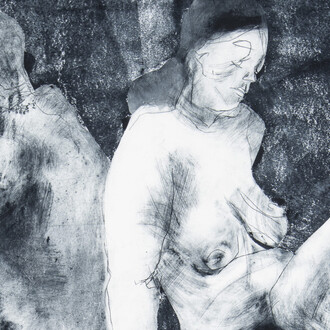The people and props that I use are symbols of both the contemporary life I experience and of the venerable Japanese traditions I admire. I also look at my paintings as Kabuki plays, the ancient Japanese equivalent to movies. I am the director, and I have to be careful casting each actress and actor because the strength of each work depends on how I script, draw, and paint each one. I call my work Masami-za or Masami-theatre.
(Masami Teraoka)
From the early 1970s Japanese-American artist Masami Teraoka adopted the traditional visual vocabulary of 17th–19th century Japanese ukiyo-e woodblock prints to comment on the world around him. These included reflections on contemporary themes such as globalisation, collisions between Asian and western cultures, and the AIDS crisis. Inspired notably by kabuki theatre prints and the ukiyo-e genres of bijin-ga [beautiful women], yūrei-zu [supernatural beings], and shunga [erotic prints], Teraoka created dramatic compositions rich in symbolism.
The National Gallery will present key examples of Teraoka’s ukiyo-e style works alongside historic ukiyo-e prints, delving into their visual, strategic and thematic connections. Leading ukiyo-e artists featured include Utagawa Kunisada, Katsushika Hokusai, Utagawa Kuniyoshi, Toyohara Kunichika and Tsukioka Yoshitoshi.
Forming part of the National Gallery’s Kenneth E. Tyler Collection exhibition series, this display will focus on Teraoka’s Hawaii Snorkel Series, published by Tyler Graphics in 1992–93. Related trial proofs and archival materials will showcase the hybrid techniques and innovative approaches Tyler employed to help Teraoka realise his vision.



![Tsukioka Yoshitoshi, Looking tasty: the appearance of a prostitute during the Kaei era (1848- 1854) [Muma-so: Kaeo nenkan joro no fuzoku], 1888](http://media.meer.com/attachments/65a8c60a578377a8b409e061db80d21e3149eba8/store/fill/410/615/1dcac09ed19e98ba5a72fd1510384bf32a4018c77253b6fd11f887e4353e/Tsukioka-Yoshitoshi-Looking-tasty-the-appearance-of-a-prostitute-during-the-Kaei-era-1848-1854.jpg)
![Tsukioka Yoshitoshi, The heavy basket [Omoi tsuzura], 1892](http://media.meer.com/attachments/2cfea7b8ae6800087879e242ae77404a04812206/store/fill/410/615/c7dda6460edad0f6f081188101a9fce0e9668c321a0e807147752f1e4378/Tsukioka-Yoshitoshi-The-heavy-basket-Omoi-tsuzura-1892.jpg)







